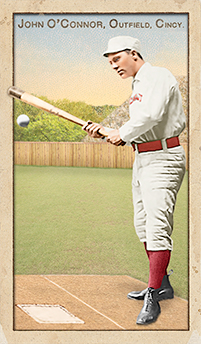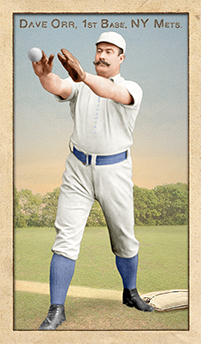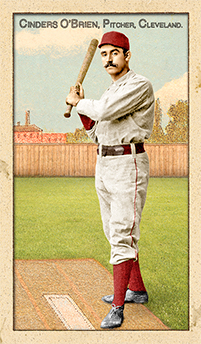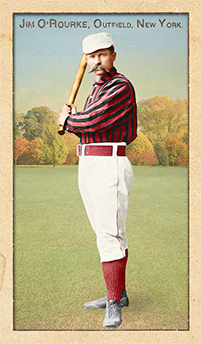- Series: Beginnings: 1880's
- City: Cleveland
- Team: Spiders
- League: National League
John F. O’Brien (1867-1892) pitched four seasons in the majors, changing leagues every year. He played in the AA, the NL, & the Players’ League – all for Cleveland teams, and moved to the Boston Reds in the AA for the 1891 season, his last due to his untimely death from pneumonia the next year.
- Had signed with Cincinnati to play in ’92 but passed away at his home in Troy, NY
- Was 18-13 for the pennant-winning Boston club in ‘91
- Series: Beginnings: 1880's
- City: Brooklyn
- Team: Bridegrooms
- League: American Association
William D. O’Brien (1863-1893) was an outfielder for the NY Metropolitans in his rookie year, 1887, and then played five years with the Brooklyn Bridegrooms. A speedster, O’Brien stole 321 bases in his illness-shortened career, hitting .282 with an OBP of .344. One of those with the distinction of playing for Brooklyn’s pennant winners in the AA in ’89 and NL in 1890.
- Ill when he reported for spring training in ’93, team raised money and sent him to CO to heal
- The weakened O’Brien succumbed to typhoid fever at the age of 29

- Series: Beginnings: 1880's
- City: Baltimore
- Team: Orioles
- League: American Association
John K. O'Brien (nee Bryne) (1860-1910) was a rare find for Billy Sharsig and his Athletics in 1881--a catcher who could hit. Jack joined the new franchise in its season in the Eastern Championship League and stayed on when the club joined the American Association the following year. By the '83 season, Jack would lead his team to the pennant, driving in a team-high 70 runs with a .290 average. O'Brien had entered baseball out west with the San Francisco-Reno team in the Pacific League as a raw 19 year old. He eventually played six of his eight major league seasons with the Athletics, for whom he always hit remarkably well for his position and era. His two years away from Philly with Brooklyn and Baltimore were struggles for him at the plate, but still exceeded the usual output for a catcher. Overall, Jack had a lifetime .266 BA in 555 games, driving in 308.
- Proving he wasn't quite done after his final year in Philadelphia, O'Brien signed on for the 1891 season with the St. Paul Apostles/Duluth Whalebacks of the Western Association where he hit .317 in 97 games
- In SF, Jack played with Sandy Nava, who would become the first Mexican-American in the major leagues with Providence and Baltimore
- Although the Old Judge series features nine known poses of Jack O'Brien, I could not find one of suitable quality for this project. This image is taken from an Old Judge proof taken at the same time as O'Brien's other OJ images and may represent an as-of-yet undiscovered pose.
- O'Brien’s uniform color on this card was changed in May, 2017 from black/red to blue/red to reflect recent reliable research by Craig Brown & friends at Threads of Our Game. Two cards had been previously released featuring a black uniform.

- Series: Beginnings: 1880's
- City: Omaha
- Team: Omahogs
- League: Western Association
Patrick H. O’Connell (1861-1943) had a very short-lived experience in the majors. He played mostly outfield during part of the 1886 season for the Baltimore Orioles of the American Association. He started 41 of his 42 games in the field, played one at first base and relieved for three innings in a game. His woeful batting (.181 average) was eclipsed by his even more inept play in the pastures as he committed 17 errors on 78 chances. By contrast, Jumbo Davis, the third baseman, handled 231 plays and muffed only 35 at the hot corner. O’Connell’s path crossed with Sandy Nava in his last appearance in the majors that season. Nava was the first known Mexican-American to play in the big leagues and was closing out what had been primarily a National League career.
Pat had broken in with Lawrence of the Eastern New England League in 1885. The Maine native continued briefly with Lawrence the next year before going back closer to home in Portland prior to making the jump to the AA later in ‘86. O’Connell found more playing time out west. He moved to Oshkosh in the Northwestern League for the ‘87 season and saw the most action of his pro career. He played regularly at first base and hit a resounding .354 in 116 games. From Wisconsin, Pat’s playing career declined quickly. He got into 84 games with the Omaha Omahogs in ‘88 and fewer than half that for two clubs the next year. After several years absence, Pat resurfaced in 1895 with the New Bedford Whalers of the New England League. At 34 he was the old man on the club.
- The Old Judge production department oftentimes misidentified Pat O'Connell on his cards as being a member of the Des Moines Prohibitionists of the Western League, occasionally listing his name as "Connell." A Peter J. Connell did play for Des Moines that year, and is one of 39 subjects who make a one pose appearance in the Old Judge cannon. (Mike Dorgan, by contrast, singularly leads the OJ cohort with 17 different poses.) Because of the confusion, this Pat O'Connell is oftentimes cited as PJ O'Connell. Such mix-ups are fairly common in the OJ series as the intrepid Old Judge crew sought to document as many players as possible in an era of shoddy record-keeping.

- Series: Beginnings: 1880's
- City: Cincinnati
- Team: Red Stockings (AA)
- League: American Association
John Joseph O’Connor (1866-1937) was as durable as they come. He holds the distinction, with a mere 28 others, of playing in four different decades in the majors. His durability was a product of his toughness. Despite the benign-sounding nickname of “Peach Pie,” O’Connor was known as one of the dirtiest players of his day and hard as nails. He excelled behind the plate, a position that devoured its occupants. With the Cleveland Spiders from 1892-98, O’Connor (also known as “Rowdy Jack”) hit .290+ four straight seasons. In his 21-year big league career, Jack hit a fine .263 He had started out with Cincinnati’s Red Stockings in 1887 and stayed in the Buckeye State with the Columbus Solons and Cleveland until he moved to St. Louis following the ‘98 campaign. He would move on to Pittsburgh and New York before landing back in St. Louis in 1904 where he remained through 1910.
Jack's waning days in St. Louis proved fateful for he and two of the game's all-time great hitters. Nap Lajoie and Ty Cobb were locked in a memorable duel for the batting title (and thus, the 1910 Chalmers Award) as the season wound down. O’Connor was the player/manager of the Browns when Lajoie’s Naps came to town for a season-ending double-header at Sportsman’s Park. History doesn’t record why O’Connor so strongly preferred Nap to win the title, but we might suppose Cobb wasn’t any more beloved in St. Louis than elsewhere. In any event, “Peach Pie” ordered his rookie third baseman Red Corriden to play back . . . way back, as in short left field. Lajoie proceeded to drop five bunts down the line, all for base hits. Lajoie reached base on his 6th at bat on a fielder's error, but O'Connor tried to bribe the official scorer to change the error to a hit, even offering to buy the woman a new wardrobe. The batting title and Chalmers Award went to Cobb despite the host’s accommodation. The difference in final average was minute, and the controversy inspired Chalmers to give both Lajoie and Cobb new cars. But the escapade cost O’Connor his job as league president Ban Johnson ordered him and Browns' owner Robert Hedges fired and banned. Decades later, research found Cobb had been double-credited with one day’s results. In 1981 Lajoie was declared the true winner of the batting title for 1910, by seven thousandths of a point. Rowdy Jack’s revenge….
- O'Connor's stunt got him blacklisted and unofficially banned from major league baseball for life
- At age 46, Jack returned to Cleveland’s Forest City club in 1912 for a last hurrah. No data survives for that team’s year but Baseball Reference records O’Connor managed the squad
- Series: Beginnings: 1880's
- City: Washington, D.C.
- Team: Nationals
- League: National League
- Hall: National Baseball Hall of Fame
“The Reverend” (1859-1935). O’Day was a pitcher & occasional position player over 7 ML seasons for 5 teams. Hank then umpired for 30 years, interrupting his tenure twice: to manage the Cincinnati Reds in 1912 and the Chicago Cubs in 1914.
- Member of ’89 Champion Giants
- Umpired 10 World Series
- Officiated Merkle’s Boner
- Called 4 no-hitters in 4 decades
- Only person to play, manage & umpire in NL
- Elected to Hall of Fame: 2013
- O'Day’s uniform color on this card was changed in August, 2017 from black to blue to reflect recent reliable research by Craig Brown & friends at Threads of Our Game. Nine cards were previously released featuring a black uniform.

- Series: Beginnings: 1880's
- City: St. Louis
- Team: Browns (AA)
- League: American League
- Hall: Canadian Baseball Hall of Fame
James Edward O’Neill (1858-1915) came out of Woodstock, Ontario to take the American Association by storm, becoming Canada’s Babe Ruth. Tip debuted with the NL’s Gothams in 1883 as a pitcher, receiving tepid reviews. He made a better impression on Charles Comiskey who signed him the next season in St. Louis to replace switch-pitching Tony Mullane. The following year theWoodstock Wonder came into his own at the plate. He became the Browns’ best hitter and led the team to four straight pennants, then falling second to Brooklyn in ‘89. Ever loyal to Comiskey, Tip followed his leader to the Players’ League Chicago Pirates, back to St. Louis in ‘91 and on to Cincinnati for his final campaign the next year. In his decade at the pinnacle of the game, O’Neill established one of the best hitting records of the 19th century: .326 BA, .458 slugging and a Triple Crown. He and Paul Hines remain the only such champions eligible for the Hall to be excluded (a fate shared with all the greats who played primarily in the AA, save for Bid McPhee).
- Tip’s excellence is commemorated north of the border with the Tip O’Neill Award given annually by the Canadian Baseball Hall of Fame
- U.S. Speaker of the House “Tip” O’Neill was nicknamed after James
- Elected to Canadian BB Hall of Fame: 1983
- Series: Beginnings: 1880's
- City: New York
- Team: Giants
- League: National League
- Hall: National Baseball Hall of Fame
James Henry O’Rourke (1850-1919) made the National League’s first base hit, and went on to a 21-year, Hall of Fame career. From 1876-92, only Cap Anson played in more games or got more hits. After leaving MLB for the minors, O’Rourke returned for his swan song with his pal John McGraw’s Giants, becoming the oldest player (at 54) to play in the NL and to get a hit.
- Played for 5 pennant winners and was NA HR champ in 1874-75
- One of only 29 to play in MLB in four decades
- Entered the HOF as one of the first 19th Century players to do so
- Elected to Hall of Fame: 1945

- Series: Beginnings: 1880's
- City: New York
- Team: Metropolitans
- League: American Association
David L. Orr (1859-1915). A 1st baseman for 5 teams over 7 major league seasons, Orr was one of the best hitters of the 1880s. Largely forgotten today, Orr may have made a case for the Hall of Fame were it not for a career-ending, paralyzing stroke suffered on the field in 1890. Dave’s .342 lifetime average is 11th all-time & in 4 of 7 seasons, his closest comp is Dan Brouthers.
Brouthers himself believed Orr was the greatest hitter of his time:
"The greatest hitter that ever played ball was old Dave Orr. He didn't care whether they were over the plate or not. If they were within reach of that long bat of his he would hit them out, and when he hit them there was no telling whether they would be found again or not. I have always held that Dave Orr was the strongest and best hitter that ever played ball." - Dan Brouthers, Sporting Life, 1894
- Won AA batting title: 1884
- Won AA RBI crown: 1884
- Lead AA in hits: 1884 & 1886
- Lead AA in triples: 1885 & 1886
- The team identification on this card was corrected in September, 2017, from Brooklyn to the NY Metropolitans. While Orr did play for Brooklyn in 1888, this photo was taken in 1887 when Orr was a member of the Mets and, indeed, he is wearing a Mets uniform. Nine cards were previously sold identifying Orr as a member of the Brooklyn club.








